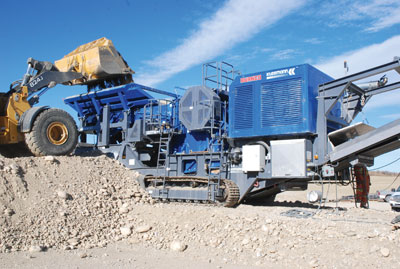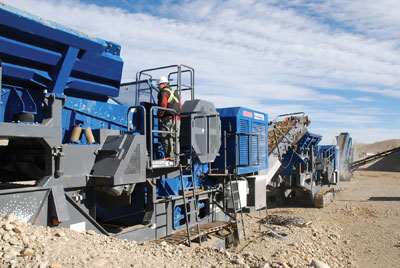
Features
Aggregates
Profiles
Interlinked Plants Help BURNCO Enter RAP, RCA Processing
A Calgary company is using some new equipment in its first foray into materials recycling.
June 13, 2011 By Tom Kuennen
Last year, fourth-generation, privately owned, Calgary-based BURNCO Rock
Products Ltd. acquired three new minerals processing plants: a Mobicat
MC 120 Z jaw crusher; a Mobirex MR 122 Z impact crusher; and a
Mobiscreen M 19 D mobile screen.
Last year, fourth-generation, privately owned, Calgary-based BURNCO Rock Products Ltd. acquired three new minerals processing plants: a Mobicat MC 120 Z jaw crusher; a Mobirex MR 122 Z impact crusher; and a Mobiscreen M 19 D mobile screen.
 |
|
| Raw gravel and sand is fed into hopper of BURNCO’s new Mobicat MC 120 Z primary jaw crusher.
|
BURNCO is using its suite of three new Kleemann plants together to profitably produce aggregates, and individually to enter the growing market for processed reclaimed asphalt pavement (RAP) and recycled concrete aggregates (RCA).
When “interlinked” and run together using technology designed into the equipment, the three plants can work as a team, enhancing throughput and productivity. They work in conjunction with each other, and are coordinated in terms of performance and function. For example, a blockage at a downstream plant will cause upstream interlinked plants to slow or stop production automatically.
But they also can work individually, and as impact crushers are the preferred means of processing RAP and RCA, BURNCO intends to use its impactor individually, moving it from stockpile to stockpile, “beneficiating” the raw recycle material to add value.
At the same time, BURNCO always will have the option of linking the plants together for large-scale, high-productivity aggregate processing. The choice is BURNCO’s.
“We didn’t buy the impactor to crush gravel,” said Mark Skjaveland, C.E.T., operations manger, production operations, for BURNCO. “We bought it to recycle products. But we can use it for other products when we need to, for example, when we are in a tight bind, to crush gravel, and keep the wolves at bay.”
BURNCO is a major player in western Canada in aggregate processing. The firm operates nine crushing plants and six wash plants, most of which migrate among 20 sand and gravel pits and one limestone quarry. The firm also has established a foothold in northeastern British Columbia with a handful of quarries.
Entering Recycling Market
“This is our first foray into materials recycling,” said Kim Titus, C.E.T., vice president, BURNCO Aggregates Division. “In the past we did not crush recycle material. Instead we would bring another company in to do the crushing. On the good side, in our first attempt at recycling, we went with Kleemann.”
 |
|
| A Mobicat MC 120 Z jaw crusher (foreground) feeds interlinked Mobirex MR 122 Z impactor and Mobiscreen M 19 D mobile screen for BURNCO just north of Calgary, Alta.
|
BURNCO will use its new Kleemann plants to crush concrete and asphalt, Skjaveland said. While the processing and stockpile activity will take place within the firm’s extraction and plant sites, BURNCO also has the capability of crushing on urban demolition sites.
“Despite our years of experience in aggregates, the crushing of recycled materials constitutes a new area for us, but as we were hiring more and more of our work out to subcontractors, it made sense to go it alone,” Skjaveland said. “We saw the market was growing, and we ourselves had too much product that had to be recycled, so we thought we would benefit from taking the step and get into it.”
Skjaveland described the mounting piles of recycle material in BURNCO’s own yards. “We have growing stockpiles of broken concrete and asphalt,” he said. “We’ve seen these piles grow and grow, and the cost of subcontracting that crushing also kept going up. That’s why we made the decision to get into recycle processing.”
“Also, the asphalt industry is feeding at least 10% RAP into their mixes,” Titus said. “RAP has become so important. And many of our customers say they have too much of the broken-out concrete and asphalt, with no place to store it. They ask if we would accept it in our pits. We’ve done that to a degree, and now we are faced with the need to recycle it into either RAP for hot mix, or a road gravel material.”
When it comes to RAP, BURNCO will crush it into 5/8-in (16-mm) product, all the way down. “That way it’s all one product, we don’t separate RAP into multiple sizes,” Skjaveland said. “Concrete will be crushed to a 3-in (75-mm) material, or a 3/4-in (20-mm) material.”
Investigating Purchase Decision
BURNCO looked long and hard in investigating which equipment would be right for them and RAP, and last year local distributor SMS Equipment introduced them to the Kleemann brand.
“That was the time that we had become very interested, and had to get something in place so we could start crushing for next spring,” Skjaveland said. “We looked at various different recycle plants, but concluded that the Kleemann was the best plant for us.”
Weight was a big consideration, as was how long BURNCO could use the machines, and over how many years it could amortize the costs. “We looked at how the equipment was built,” Skjaveland said. “I brought my equipment maintenance supervisor with me and we saw the amount of metal that was in these machines. We noticed Kleemann had dust suppression, it had sound suppression for the cones, the jaws and the impactors. And the safety aspects – seeing all the rollers encaged in metal, for example – indicated the equipment was really well put together.”
Interlinked Plants
BURNCO’s new screening plant has the option of running electric or diesel, Skjaveland said. Thus when it’s “interlinked” with other Kleemann plants it can be plugged into either the jaw or impactor gensets, saving money and diesel fuel. Of course, it can power itself as well.
In an application last October, BURNCO was running the three plants interlinked. Staff used the self-propel feature of the plants to line them up. “We run the jaw first, and the jaw reduces the product,” Skjaveland said. “The rock goes into the impactor, which reduces it more and sends it to a screening deck. From the deck, any oversize goes back into the impactor.”
In October 2010, the interlinked plants were working a glacial deposit for sand and gravel, crushing the stone down to 3-in. (75-mm) product, at rates up to 350 tph.
“Anything that would pass a 3-in (75-mm) screen would bypass the jaw,” Skjaveland said. “Anything above that would be crushed down, and all that material would go into the impactor, which will pass 2-in (50-mm) stone to go directly to the screen. All oversize rock would be crushed in the impactor and recirculated until it’s sized properly.”
The ultimate use of this product is road base. “It’s a City of Calgary specification for road building,” Titus said. “They will call for 6 to 8 in. of 75-mm crushed gravel, top it off with a 20 to 25-mm, and pave over all.”
“The plants are interlinked with a CPU system,” said Paul McLaren,
Kleemann service manager. “If you get a shut down on one of the machines downstream of the material, it shuts everything down upstream so the material doesn’t carry on and overload it.”
Thus, in BURNCO’s set up, if a conveyor belt breaks and the screen shuts down, the impactor and the jaw both will shut down; or if the impactor has a blockage and shuts down, it only will shut down the jaw while allowing the screen to run until all the material is out. But if an emergency stop is effected, the entire system will shut down.
“Everything is automated,” McLaren said. “It has an automated start-up and shut-down process. Everything looks after itself. The only guy that is doing anything is the loader operator, bringing material to charge
the hopper.”
Also, an overpressure system keeps dust out of all the electrical cabinets. “It increases the air pressure inside the control cabinets,” McLaren said. “The higher pressure keeps the outside atmosphere outside. Not only does it keep dust out; it keeps any moisture out, and keeps the components cool because air continues to flow over them. It maintains a good environment for the electrical components.”
And BURNCO’s system was taking advantage of the electrical power sharing available through the plant interlinking. “The jaw crusher and the impact crusher are the only two engines we have running,” McLaren said. “The screen is running off the electrical supply of the impact crusher. And we also have extra power we can use; they have a mobile lunch room and two stackers which are being supplied from the Kleemann plants.”
Kleemann in North America
Kleemann is a newcomer to the North American aggregate processing market, but its roots lie deep.
Established in Germany in 1857, Kleemann was acquired by Wirtgen Group in 2006. Now, a growing network of equipment distributors and dealers is enabling Kleemann to boost its domestic profile and serve customers in North America.
Today Kleemann manufactures and markets a broad range of durable, productive mobile and stationary processing equipment and technology for crushed stone, demolition waste and mixed construction waste.
Print this page